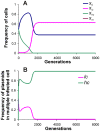Sociobiological control of plasmid copy number in bacteria
- PMID: 20195362
- PMCID: PMC2827543
- DOI: 10.1371/journal.pone.0009328
Sociobiological control of plasmid copy number in bacteria
Abstract
All genes critical for plasmid replication regulation are located on the plasmid rather than on the host chromosome. It is possible therefore that there can be copy-up "cheater" mutants. In spite of this possibility, low copy number plasmids appear to exist stably in host populations. We examined this paradox using a multilevel selection model. Simulations showed that, a slightly higher copy number mutant could out-compete the wild type. Consequently, another mutant with still higher copy number could invade the first invader. However, the realized benefit of increasing intra-host fitness was saturating whereas that of inter-host fitness was exponential. As a result, above a threshold, intra-host selection was overcompensated by inter-host selection and the low copy number wild type plasmid could back invade a very high copy number plasmid. This led to a rock-paper-scissor (RPS) like situation that allowed the coexistence of plasmids with varied copy numbers. Furthermore, another type of cheater that had lost the genes required for conjugation but could hitchhike on a conjugal plasmid, could further reduce the advantage of copy-up mutants. These sociobiological interactions may compliment molecular mechanisms of replication regulation in stabilizing the copy numbers.
Conflict of interest statement
Figures






Similar articles
-
The host range of RK2 minimal replicon copy-up mutants is limited by species-specific differences in the maximum tolerable copy number.Plasmid. 1995 Jan;33(1):27-39. doi: 10.1006/plas.1995.1004. Plasmid. 1995. PMID: 7753906
-
Prevalence and significance of plasmid maintenance functions in the virulence plasmids of pathogenic bacteria.Infect Immun. 2011 Jul;79(7):2502-9. doi: 10.1128/IAI.00127-11. Epub 2011 May 9. Infect Immun. 2011. PMID: 21555398 Free PMC article. Review.
-
Trans-complementable copy-number mutants of plasmid ColE1.Nature. 1980 Jan 10;283(5743):216-8. doi: 10.1038/283216a0. Nature. 1980. PMID: 7350544
-
Evolutionary rescue of bacterial populations by heterozygosity on multicopy plasmids.J Math Biol. 2025 Feb 6;90(3):26. doi: 10.1007/s00285-025-02182-4. J Math Biol. 2025. PMID: 39909926 Free PMC article.
-
Replication and conjugative mobilization of broad host-range IncQ plasmids.Plasmid. 2009 Sep;62(2):57-70. doi: 10.1016/j.plasmid.2009.05.001. Epub 2009 May 22. Plasmid. 2009. PMID: 19465049 Free PMC article. Review.
Cited by
-
Genomic epidemiology of global Klebsiella pneumoniae carbapenemase (KPC)-producing Escherichia coli.Sci Rep. 2017 Jul 19;7(1):5917. doi: 10.1038/s41598-017-06256-2. Sci Rep. 2017. PMID: 28725045 Free PMC article.
-
Broad Dissemination of Plasmids across Groundwater-Fed Rapid Sand Filter Microbiomes.mBio. 2021 Dec 21;12(6):e0306821. doi: 10.1128/mBio.03068-21. Epub 2021 Nov 30. mBio. 2021. PMID: 34844427 Free PMC article.
-
Intra- and interpopulation transposition of mobile genetic elements driven by antibiotic selection.Nat Ecol Evol. 2022 May;6(5):555-564. doi: 10.1038/s41559-022-01705-2. Epub 2022 Mar 28. Nat Ecol Evol. 2022. PMID: 35347261
-
Hotspot mutations and ColE1 plasmids contribute to the fitness of Salmonella Heidelberg in poultry litter.PLoS One. 2018 Aug 31;13(8):e0202286. doi: 10.1371/journal.pone.0202286. eCollection 2018. PLoS One. 2018. PMID: 30169497 Free PMC article.
-
Reducing metabolic burden in the PACEmid evolver system by remastering high-copy phagemid vectors.Eng Biol. 2022 May 20;6(2-3):50-61. doi: 10.1049/enb2.12021. eCollection 2022 Jun-Sep. Eng Biol. 2022. PMID: 36969104 Free PMC article.
References
-
- Gelder LD, Ponciano JM, Joyce P, Top EM. Stability of a promiscuous plasmid in different hosts: no guarantee for a long-term relationship. Microbiol. 2007;153:452–463. - PubMed
MeSH terms
LinkOut - more resources
Full Text Sources
Research Materials

